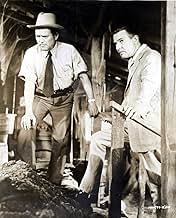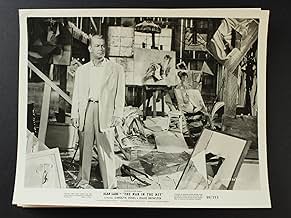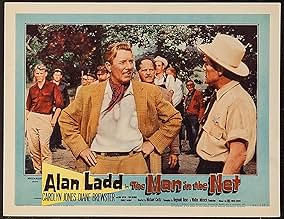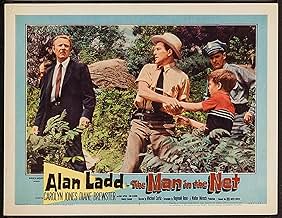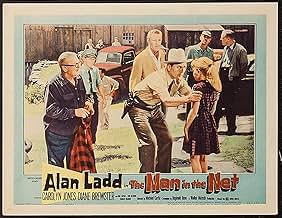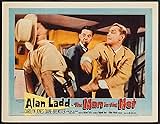NOTE IMDb
6,1/10
880
MA NOTE
Ajouter une intrigue dans votre langueA struggling artist in a small town becomes the prime suspect when his wife mysteriously disappears.A struggling artist in a small town becomes the prime suspect when his wife mysteriously disappears.A struggling artist in a small town becomes the prime suspect when his wife mysteriously disappears.
- Réalisation
- Scénario
- Casting principal
Diana Brewster
- Vickie Carey
- (as Diane Brewster)
Michael McGreevey
- Buck Ritter
- (as Mike McGreevey)
Dee Carroll
- Psychiatrist's Nurse
- (non crédité)
Bill Cassady
- State Trooper
- (non crédité)
Alvin Childress
- Alonzo
- (non crédité)
Avis à la une
With both its star Alan Ladd and its director Michael Curtiz nearing the end of their careers, The Man in the Net has a valedictory feel that surely wasn't intended. Ladd looks puffy and seems bored by issues that are literally vital to him (and his sprints through the woods look labored and abbreviated). Behind the camera, Curtiz fares a bit better; the old pro (Casablanca, Mildred Pierce) knows how to shape a story and sustain tension, but he didn't bother to plaster over the cracks in the far-fetched screenplay by Reginald Rose.
Ladd plays a commercial artist who has moved to rural Connecticut to pursue his dream of becoming a serious painter; another reason for leaving New York's `rat race' was the gin-fueled nervous breakdown of his wife (Carolyn Jones). She still chafes under their genteel poverty when she knows he could make big bucks by returning to his old job. She takes her revenge in a clandestine affair (all the while trying to look and act like Bette Davis as Rosa Moline in Beyond The Forest).
When Ladd takes a commuter train into the city to turn down the job and incidentally to visit her psychiatrist (isn't it customary for the patient to go?), he returns to find all his paintings slashed and a typewritten note telling him she's left for good. But then a suitcase full of her clothes is found burning at the local dump, and other evidence points to foul play. The townspeople, who range from rural bumpkins to the country gentry, jump to the conclusion that the aloof Ladd murdered Jones. They profess shock at Ladd's revelation that she was a drinker, even though she has already staged a drunken scene at a big party where the hosts know her well enough to have a `special tomato juice' waiting for her.
Then we're asked to buy the spectacle of this Connecticut town, in 1959, turning into a Balkan village, with a lynch mob gathered in pursuit of a short, middle-aged white male. Luckily for Ladd, he's forged bonds of trust with a bevy of children whom he's forever sketching in the bosky glades (this seems a stretch, as he appears as stiff and uncomfortable being with them as they do being in front of a camera). They hide him in a surprisingly spacious and well-appointed cave they use as their clubhouse, and, at his bidding, undertake a series of ruses to smoke out the real killer. There's enough going on in Man in the Net to keep you watching, including Charles McGraw as a surly sheriff, but it's not fresh enough to make you suspend your considerable disbelief.
Ladd plays a commercial artist who has moved to rural Connecticut to pursue his dream of becoming a serious painter; another reason for leaving New York's `rat race' was the gin-fueled nervous breakdown of his wife (Carolyn Jones). She still chafes under their genteel poverty when she knows he could make big bucks by returning to his old job. She takes her revenge in a clandestine affair (all the while trying to look and act like Bette Davis as Rosa Moline in Beyond The Forest).
When Ladd takes a commuter train into the city to turn down the job and incidentally to visit her psychiatrist (isn't it customary for the patient to go?), he returns to find all his paintings slashed and a typewritten note telling him she's left for good. But then a suitcase full of her clothes is found burning at the local dump, and other evidence points to foul play. The townspeople, who range from rural bumpkins to the country gentry, jump to the conclusion that the aloof Ladd murdered Jones. They profess shock at Ladd's revelation that she was a drinker, even though she has already staged a drunken scene at a big party where the hosts know her well enough to have a `special tomato juice' waiting for her.
Then we're asked to buy the spectacle of this Connecticut town, in 1959, turning into a Balkan village, with a lynch mob gathered in pursuit of a short, middle-aged white male. Luckily for Ladd, he's forged bonds of trust with a bevy of children whom he's forever sketching in the bosky glades (this seems a stretch, as he appears as stiff and uncomfortable being with them as they do being in front of a camera). They hide him in a surprisingly spacious and well-appointed cave they use as their clubhouse, and, at his bidding, undertake a series of ruses to smoke out the real killer. There's enough going on in Man in the Net to keep you watching, including Charles McGraw as a surly sheriff, but it's not fresh enough to make you suspend your considerable disbelief.
In "the proud rebel" , Alan Ladd played opposite a child,his own son ; in the very first sequence,he is surrounded by a bunch of kids who do not think his drawings are "dirty "; this sequence is rather long and may seem boring and soppy ;but it's vital .Hadn't the artist been good friends with the children of the neighbourhood, he would have been perhaps lynched by the populace -although it's a bit exagerated , his wife being not so popular in the vicinity.
The murder mystery is quite trite ,with the cardboard character of the alcoholical hysterical wife (Carolyn Jones ) ,and the trap the fugitive uses to clear himself of the accusation somewhat far-fetched .
The film's main interest lies in the children's intervention ,the last bastion against the maddening crowd ; for them ,it's the greatest game they have ever played ,and to hide the fugitive in their own "den" is extremely exciting ;their relationship with the wrong man makes up for the paucity of the detective story.
The murder mystery is quite trite ,with the cardboard character of the alcoholical hysterical wife (Carolyn Jones ) ,and the trap the fugitive uses to clear himself of the accusation somewhat far-fetched .
The film's main interest lies in the children's intervention ,the last bastion against the maddening crowd ; for them ,it's the greatest game they have ever played ,and to hide the fugitive in their own "den" is extremely exciting ;their relationship with the wrong man makes up for the paucity of the detective story.
The Man in the Net (1959)
What a great movie with a flawed Alan Ladd bringing it down. This is toward the end of his career, and he plays his part, of a man falsely accused of a crime, with such deadpan reluctance, you think he's being forced to act. We do feel for him because the plot is so clear about the facts, but we can't really get emotionally involved. The movie around him a late 50s modernity mixed with old school Hollywood pace and mise-en-scene, thanks to veteran director Michael Curtiz ("Casablanca" and "Mildred Pierce").
The real star is the almost unknown Carolyn Jones--almost unknown, except as Morticia in The Addams Family (mid-60 television, for the uninitiated). She played a number of important secondary roles films of the 1950s, but also had a t.v. career, and who know why she never quite made it. But, she shows up here right away and is astonishing, like a young Bette Davis, even with the same wide eyes and snappy mannerisms. She plays Ladd's wife, and at first she seems merely feisty. Then you realize she's a live wire inside, and possibly drinking too much. And then it cracks open from there, and Jones makes the character cunning and yet also weirdly enchanting.
The other fascinating turn to the storytelling is the role children play in it all (a little ironic given that the movie promotions say loudly: not appropriate for children). At first the group of five kids, all under 10, are part of the innocence of this little Connecticut town far from the ravages of New York. Then a lot of adult stuff happens, the good stuff really, the stuff that Curtiz has the best feel for. Then the children reappear, and it almost becomes a two layer movie, with the children keeping a kind of fairy tale element to what is a very very horrible situation. In fact, as the townspeople become more and more childish (and cruel), the kids become reasonable and mature.
But then there is Ladd. Even reviewers at the time (when Ladd was still riding his star power) remarked that he was all wood and clay (or as Richard Neson said in 1959, Ladd "mutes his personality to the point of unreality"). Even physically he seems a bit awkward, making me think he was getting old, even though he needed to be in his 30s or 40s for the part and was only 45 at the time of shooting.
So, this is an odd beast of a film, but a truly interesting one. Even the story has a quirky genesis--the author being listed as Patrick Quentin, which was a pen name for a group of four writers who pounded out popular detective fiction. Certainly anything by Curtiz is worth a look, and the direction, per se, is actually first rate, if we can overlook his handling of his lead male. And the cinematographer is the wonderful John Seitz,which helps with a lot of the scenes (the cave scenes, the party). The movie almost has the potential to be a cult classic, like "Night of the Hunter," but Ladd never was as commanding as Robert Mitchum, was he?
What a great movie with a flawed Alan Ladd bringing it down. This is toward the end of his career, and he plays his part, of a man falsely accused of a crime, with such deadpan reluctance, you think he's being forced to act. We do feel for him because the plot is so clear about the facts, but we can't really get emotionally involved. The movie around him a late 50s modernity mixed with old school Hollywood pace and mise-en-scene, thanks to veteran director Michael Curtiz ("Casablanca" and "Mildred Pierce").
The real star is the almost unknown Carolyn Jones--almost unknown, except as Morticia in The Addams Family (mid-60 television, for the uninitiated). She played a number of important secondary roles films of the 1950s, but also had a t.v. career, and who know why she never quite made it. But, she shows up here right away and is astonishing, like a young Bette Davis, even with the same wide eyes and snappy mannerisms. She plays Ladd's wife, and at first she seems merely feisty. Then you realize she's a live wire inside, and possibly drinking too much. And then it cracks open from there, and Jones makes the character cunning and yet also weirdly enchanting.
The other fascinating turn to the storytelling is the role children play in it all (a little ironic given that the movie promotions say loudly: not appropriate for children). At first the group of five kids, all under 10, are part of the innocence of this little Connecticut town far from the ravages of New York. Then a lot of adult stuff happens, the good stuff really, the stuff that Curtiz has the best feel for. Then the children reappear, and it almost becomes a two layer movie, with the children keeping a kind of fairy tale element to what is a very very horrible situation. In fact, as the townspeople become more and more childish (and cruel), the kids become reasonable and mature.
But then there is Ladd. Even reviewers at the time (when Ladd was still riding his star power) remarked that he was all wood and clay (or as Richard Neson said in 1959, Ladd "mutes his personality to the point of unreality"). Even physically he seems a bit awkward, making me think he was getting old, even though he needed to be in his 30s or 40s for the part and was only 45 at the time of shooting.
So, this is an odd beast of a film, but a truly interesting one. Even the story has a quirky genesis--the author being listed as Patrick Quentin, which was a pen name for a group of four writers who pounded out popular detective fiction. Certainly anything by Curtiz is worth a look, and the direction, per se, is actually first rate, if we can overlook his handling of his lead male. And the cinematographer is the wonderful John Seitz,which helps with a lot of the scenes (the cave scenes, the party). The movie almost has the potential to be a cult classic, like "Night of the Hunter," but Ladd never was as commanding as Robert Mitchum, was he?
Like a lot of classic film stars, Alan Ladd's career ended on a low rather than a high note, and one of his last films, 1959's Man in the Net, is a good example of this. It was also one of the last films for director Michael Curtiz who directed such classics as "Casablanca." It's a poor effort from such an accomplished man.
Ladd plays an artist who has left the pressure of NYC and his full time job in order to paint. He spends most of his time in the woods, painting, while a group of local kids play nearby and talk with him. His major problem isn't the brushes and colors, though, it's his wife (Carolyn Jones), an alcoholic who wants to return to the social atmosphere that helped her drinking along in the first place. Here in the boondocks, she's hooked up with the ritzy set, to Ladd's displeasure.
When he returns from a business trip to New York City, his wife is missing, there is blood on his painting clothes, his paintings have been destroyed, and everybody thinks he's responsible. With the help of the children he has befriended, he eludes the police and is able to get the proof he needs to exonerate himself.
With a tighter script and someone other than Ladd, this might have been a decent movie. The kids are adorable, and that angle of the script plays out nicely. Ladd, unfortunately, sleepwalks through the role and at times, actually looks like a blind man. I tried to figure out why, and I think it's just because he's literally staring into space instead of focusing on something. There was never anything spectacular about Ladd's acting - what he had was a presence, a toughness, and good looks. These are all gone, and in their place is a puffy, heavy-lidded, slow man.
In contrast, the striking Carolyn Jones is full of energy in her role. With her signature short haircut and Bette Davis eyes, Jones was an edgy actress who left us too soon. She was very good at playing neurotic party girls and straying wives, though she's remembered today as Morticia on "The Addams Family" TV show.
All in all, "The Man in the Net" plays like a television drama, with the suburbanites going after Ladd like they all live in the wild west. Someone commented that today he would be suspicious for hanging out with children, and that aspect dates the film as well. It's a shame, because the nicest aspect of the movie was the way the kids rallied around him and helped him.
If you loved Ladd in "This Gun for Hire," "The Glass Key," "The Blue Dahlia," and "Shane," skip this. You don't need to see a fallen star.
Ladd plays an artist who has left the pressure of NYC and his full time job in order to paint. He spends most of his time in the woods, painting, while a group of local kids play nearby and talk with him. His major problem isn't the brushes and colors, though, it's his wife (Carolyn Jones), an alcoholic who wants to return to the social atmosphere that helped her drinking along in the first place. Here in the boondocks, she's hooked up with the ritzy set, to Ladd's displeasure.
When he returns from a business trip to New York City, his wife is missing, there is blood on his painting clothes, his paintings have been destroyed, and everybody thinks he's responsible. With the help of the children he has befriended, he eludes the police and is able to get the proof he needs to exonerate himself.
With a tighter script and someone other than Ladd, this might have been a decent movie. The kids are adorable, and that angle of the script plays out nicely. Ladd, unfortunately, sleepwalks through the role and at times, actually looks like a blind man. I tried to figure out why, and I think it's just because he's literally staring into space instead of focusing on something. There was never anything spectacular about Ladd's acting - what he had was a presence, a toughness, and good looks. These are all gone, and in their place is a puffy, heavy-lidded, slow man.
In contrast, the striking Carolyn Jones is full of energy in her role. With her signature short haircut and Bette Davis eyes, Jones was an edgy actress who left us too soon. She was very good at playing neurotic party girls and straying wives, though she's remembered today as Morticia on "The Addams Family" TV show.
All in all, "The Man in the Net" plays like a television drama, with the suburbanites going after Ladd like they all live in the wild west. Someone commented that today he would be suspicious for hanging out with children, and that aspect dates the film as well. It's a shame, because the nicest aspect of the movie was the way the kids rallied around him and helped him.
If you loved Ladd in "This Gun for Hire," "The Glass Key," "The Blue Dahlia," and "Shane," skip this. You don't need to see a fallen star.
An unwatchable late-in-career Alan Ladd vehicle, "The Man in the Net" is an extremely poor movie. Writer Reginald Rose, whose "12 Angry Men" is a certifiable classic, should be ashamed of this one.
The first half hour, setting up the story and characters, is overwritten to make Ladd, miscast as a dedicated artist who's fled the NYC rat race to pursue his art in bucolic Connecticut, the story's hero and his wife Carolyn Jones a monster. Rose's portrait of her as an alcoholic creep dumping on Ladd constantly for not selling out to be a commercial artist and returning them to her comfy social life in the Big Apple is ridiculously one-sided and phony. The stereotyped supporting cast is insufferable.
Act I climaxes with Ladd returning home from NYC where he turned down the ad agency job offer, only to find all his paintings destroyed and Jones missing. With stone age local cops Charles McGraw and Edward Binns on the case, the movie instantly turns into a version of Gone Girl 1.0, without any of the cleverness or subtlety of that 2014 classic that made Rosamund Pike a star.
The remaining hour of the movie goes in an entirely different direction than "Gone Girl", with a dumb subplot involving the local children who all adore Ladd, then vigilante justice rearing its ugly head and a final plot twist that is as stupid as it is unconvincing.
Worst of all is Ladd's performance. He is so dull and monotone, especially in the early reels, that if he hadn't been a Hollywood star he would have been fired and replaced with somebody who could emote a teeny bit.
The first half hour, setting up the story and characters, is overwritten to make Ladd, miscast as a dedicated artist who's fled the NYC rat race to pursue his art in bucolic Connecticut, the story's hero and his wife Carolyn Jones a monster. Rose's portrait of her as an alcoholic creep dumping on Ladd constantly for not selling out to be a commercial artist and returning them to her comfy social life in the Big Apple is ridiculously one-sided and phony. The stereotyped supporting cast is insufferable.
Act I climaxes with Ladd returning home from NYC where he turned down the ad agency job offer, only to find all his paintings destroyed and Jones missing. With stone age local cops Charles McGraw and Edward Binns on the case, the movie instantly turns into a version of Gone Girl 1.0, without any of the cleverness or subtlety of that 2014 classic that made Rosamund Pike a star.
The remaining hour of the movie goes in an entirely different direction than "Gone Girl", with a dumb subplot involving the local children who all adore Ladd, then vigilante justice rearing its ugly head and a final plot twist that is as stupid as it is unconvincing.
Worst of all is Ladd's performance. He is so dull and monotone, especially in the early reels, that if he hadn't been a Hollywood star he would have been fired and replaced with somebody who could emote a teeny bit.
Le saviez-vous
- AnecdotesFilmed in a small town in Connecticut known as Thompson. Which is located in the northeast corner of the state.
- GaffesWhen John and Brad are depicted as being on the train to New York City, the scenes through the train car's windows are bouncing up and down as if the rear-screen projection shots used were from a vehicle on the road, not from a train.
Meilleurs choix
Connectez-vous pour évaluer et suivre la liste de favoris afin de recevoir des recommandations personnalisées
- How long is The Man in the Net?Alimenté par Alexa
Détails
- Date de sortie
- Pays d’origine
- Sites officiels
- Langue
- Aussi connu sous le nom de
- En la red de una mentira
- Lieux de tournage
- Sociétés de production
- Voir plus de crédits d'entreprise sur IMDbPro
- Durée
- 1h 38min(98 min)
- Couleur
- Rapport de forme
- 1.66 : 1
Contribuer à cette page
Suggérer une modification ou ajouter du contenu manquant


